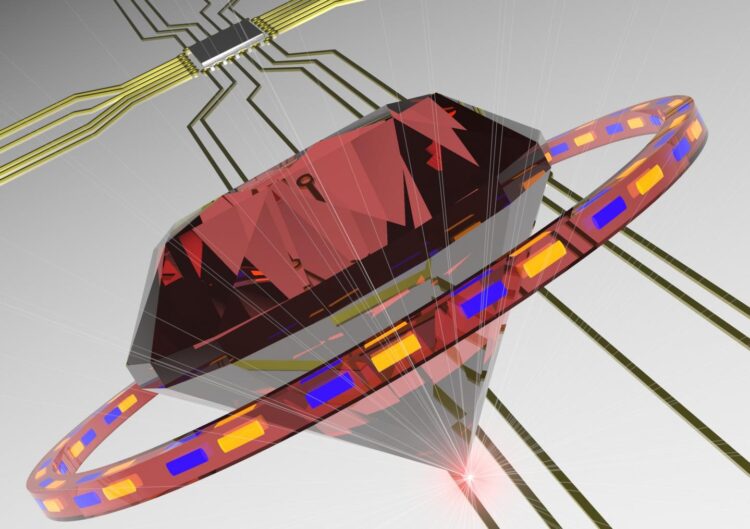Two research breakthroughs are poised to accelerate the development of synthetic diamond-based quantum technology

Credit: Igor Aharonovich
Marilyn Monroe famously sang that diamonds are a girl’s best friend, but they are also very popular with quantum scientists – with two new research breakthroughs poised to accelerate the development of synthetic diamond-based quantum technology, improve scalability, and dramatically reduce manufacturing costs.
While silicon is traditionally used for computer and mobile phone hardware, diamond has unique properties that make it particularly useful as a base for emerging quantum technologies such as quantum supercomputers, secure communications and sensors.
However there are two key problems; cost, and difficulty in fabricating the single crystal diamond layer, which is smaller than one millionth of a metre.
A research team from the ARC Centre of Excellence for Transformative Meta-Optics at the University of Technology Sydney (UTS), led by Professor Igor Aharonovich, has just published two research papers, in Nanoscale and Advanced Quantum Technologies, that address these challenges.
“For diamond to be used in quantum applications, we need to precisely engineer ‘optical defects’ in the diamond devices – cavities and waveguides – to control, manipulate and readout information in the form of qubits – the quantum version of classical computer bits,” said Professor Aharonovich.
“It’s akin to cutting holes or carving gullies in a super thin sheet of diamond, to ensure light travels and bounces in the desired direction,” he said.
To overcome the “etching” challenge, the researchers developed a new hard masking method, which uses a thin metallic tungsten layer to pattern the diamond nanostructure, enabling the creation of one-dimensional photonic crystal cavities.
“The use of tungsten as a hard mask addresses several drawbacks of diamond fabrication. It acts as a uniform restraining conductive layer to improve the viability of electron beam lithography at nanoscale resolution,” said lead author of paper in Nanoscale, UTS PhD candidate Blake Regan.
To the best of our knowledge, we offer the first evidence of the growth of a single crystal diamond structure from a polycrystalline material using a bottom up approach – like growing flowers from seed.
“It also allows the post-fabrication transfer of diamond devices onto the substrate of choice under ambient conditions. And the process can be further automated, to create modular components for diamond-based quantum photonic circuitry,” he said.
The tungsten layer is 30nm wide – around 10,000 times thinner than a human hair – however it enabled a diamond etch of over 300nm, a record selectivity for diamond processing.
A further advantage is that removal of the tungsten mask does not require the use of hydrofluoric acid – one of the most dangerous acids currently in use – so this also significantly improves the safety and accessibility of the diamond nanofabrication process.
To address the issue of cost, and improve scalability, the team further developed an innovative step to grow single crystal diamond photonic structures with embedded quantum defects from a polycrystalline substrate.
“Our process relies on lower cost large polycrystalline diamond, which is available as large wafers, unlike the traditionally used high quality single crystal diamond, which is limited to a few mm2” said UTS PhD candidate Milad Nonahal, lead author of the study in Advanced Quantum Technologies.
“To the best of our knowledge, we offer the first evidence of the growth of a single crystal diamond structure from a polycrystalline material using a bottom up approach – like growing flowers from seed,” he added.
“Our method eliminates the need for expensive diamond materials and the use of ion implantation, which is key to accelerating the commercialisation of diamond quantum hardware” said UTS Dr Mehran Kianinia, a senior author on the second study.
###
‘Nanofabrication of high Q, transferable diamond resonators’ is published in Nanoscale.
‘Bottom-Up Synthesis of Single Crystal Diamond Pyramids Containing Germanium Vacancy Centres’ is published in Advanced Quantum Technologies
.
Media Contact
Leilah Schubert
[email protected]
Original Source
https:/
Related Journal Article
http://dx.





